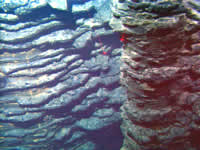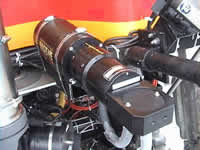| |
Teacher Logbook - NOAA Ship Ron Brown
| |

Lava pillars (with bathtub rings) at Cloud
vent.

Imagenex pencil-beam sonar mounted on ROPOS. |
|
Jeff Goodrich's Sealog:
Axial Volcano- 1998 lava flow
July 23, 2001
Pee Yew!
What smells? Sulfide. It must be those tubeworm samples again. After ROPOS
came up on deck around 1200 the scientists rushed out to the bio box and
suction sampler to collect their latest treats from the deep. Dive number
R625 brought us back to the Cloud vent area for Sabastian Durand's video/mapping
survey with a side scanning sonar called Imagenex. Imagenex is a high
frequency (675 kHz) "pencil beam" scanning-sonar used to do
high resolution (2-m grid cell size and less) bathymetric surveys. Mounted
on ROPOS with the sonar head pointing downward, it sweeps from side to
side as ROPOS flies forward resulting in a zig-zag pattern of depth soundings
under the ROV track. ROPOS flies at a< slow rate in straight tracklines
back and forth, termed "mowing the lawn." After processing the
data, a detailed map can be produced on board the ship.
Passing over
the 1998 lava flow for Sebastian Durand's survey was like flying in an
airplane a couple hundred feet over the Earth's surface. Small fissures,
canyons, mounds of broken basalt, and pillars passed underneath. The pillars
are spectacular, some rising more than 5 or 6 meters (15-18 ft.) off the
bottom. The pillars are created when an eruptive sequence takes place
in relatively flat areas on the ocean floor. Rift eruptions start with
a dike intrusion along the rift zone. Magma then pours out the ocean floor
as a thin sheet flow (10's of cm thick). The flow advances as lobes, with
gaps in between where seawater makes its way below the flow. Since the
flow comes into contact with the cold seawater, its surface forms a thin
crust. As magma continues to flow beneath the thin crust, the lava flow
inflates like a balloon and resembles a convex mirror. It now has a thin
brittle crust on top of ponded liquid magma.
Water trapped
below the lava flow heats and rises through the flow, escaping out its
surface. This creates cooled conduits (tubes) that run from the flow's
bottom to it's top. Next, the lava drains back, collapsing the thick central
portion of the lava flow. Near the edge of the collapsed area, cooled,
hardened columns surrounding the conduits are left behind and remain as
pillars (most of which are hollow). On the pillars are layered ledges
sticking out horizontally, called "bathtub rings". They were
formed during the lava drainback stage as the upper, cooling crust attaches
to the pillars. As the the deflation continues, the attached portion cools,
becomes brittle, and then breaks forming a new ledge. New lava attaches
lower on the pillar, cools and becomes brittle, then breaks again forming
yet another ledge. This process continues until the drainback is complete.
Ledged pillars are left behind. An animated sequence of this process may
be found on the NeMO Explorer web site.
Tonight we're
doing another Imagenex survey at the fascinating CASM vent field in the
northern portion of the caldera. Stay tuned.
|
|

